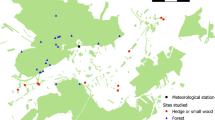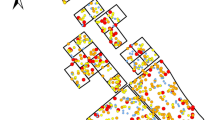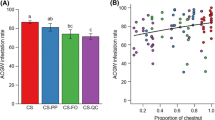Abstract
We compared the spatial distribution of stem cankers on the canopy tree Ocotea whitei (Lauraceae) in a 20-ha plot on Barro Colorado Island, Panama, with spatial and temporal patterns of mortality in this host over the previous decade. The cankers occur both on adult and juvenile individuals, aothough juveniles are much more likely the adults to show symptoms. Disease incidence is host-density dependent, and both the presence of the disease and host mortality are more likely close to than far from a conspecific adult, which resulted in a net spatial shift of the juvenile population away from conspecific adults through time. Disease incidence is lower than expected among juveniles of O. whitei growing near to adults of the non-susceptible canopy tree Beilschmiedia pendula. The coincidence of spatial patterns of canker incidence and host mortality suggest a role for the disease in regulating host spatial distribution, in agreement with predictions of the Janzen-Connell hypothesis.
Similar content being viewed by others
References
Alexander HM (1992) Fungal pathogens and the structure of plant populations and communities. In: Carroll GC, Wicklow DT (eds) The fungal community: its organization and role in the ecosystem, 2nd edn. Marcel Dekker, New York, pp 481–497
Augspurger CK (1983a) Offspring recruitment around tropical trees: changes in cohort distance with time. Oikos 40: 189–196
Augspurger CK (1983b) Seed dispersal of the tropical tree Platypodium elegans and the escape of its seedlings from fungal pathogens. J Ecol 71: 759–772
Augspurger CK (1984) Seedling survival of tropical tree species: interactions of dispersal distance, light-gaps, and pathogens. Ecology 65: 1705–1712
Augspurger CK, Kelly CK (1984) Pathogen mortality of tropical tree seedlings experimental studies of the effects of dispersal distance seedling density and light conditions. Oecologia 61: 211–217
Baldwin IT, Schultz JC (1983) Rapid changes in tree leaf chemistry induced by damage: evidence for communication between plants. Science 221: 277–279
Burdon JJ, Chilvers GA (1982) Host density as a factor in plant disease ecology. Annu Rev Phytopathol 20: 143–166
Campbell CI, Madden LV (1990) Introduction to plant disease epidemiology. John Wiley & Sons, New York
Clark DA, Clark DB (1984) Spacing dynamics of a tropical rain forest tree: evaluation of the Janzen-Connell model. Am Nat 124: 769–788
Condit R, Hubbell SP, Foster RB (1992) Recruitment near conspecific adults and the maintenance of tree and shrub diversity in a neotropical forest. Am Nat 140: 261–286
Condit R, Hubbell SP, Foster RB (1994) Density dependence in two understory tree species in a neotropical forest. Ecology (in press)
Connell JH (1971) On the role of natural enemies in preventing competitive exclusion in some marine animals and in rain forest trees. In: Boer PJ van der, Gradwell GR (eds) Dynamics of numbers in populations (Proceedings of the Advanced Study Institute, Osterbeek 1970). Centre for Agricultural Publication and Documentation, Wageningen, pp 298–312
Connell JH, Tracey JH, Webb LJ (1984) Compensatory recruitment, growth and mortality as factors maintaining rain forest tree diversity. Ecol Monogr 54: 141–164
Croat TB (1978) Flora of Barro Colorado Island. Stanford University Press, Stanford
Farmer EE, Ryan CA (1990) Interplant communication: Airborne methyl jasmonate induces synthesis of proteinase inhibitors in plant leaves. Proc Natl Acad Sci USA 87: 7713–7716
Houston DR (1984) Stress related to diseases. Arboric J 8: 137–149
Hubbell SP (1980) Seed predation and the coexistence of tree species in tropical forests. Oikos 35: 214–229
Hubbell SP, Foster RB (1987) The spatial context of regeneration in a neotropical forest. In Gray AJ, Crawley MJ, Edwards PJ (eds) Colonization, succession and stability. Blackwell Scientific Publications, Oxford, pp 395–412
Hubbell SP, Foster RB (1990) Structure, dynamics, and equilibrium status of old-growth forest on Barro Colorado Island. In: Gentry A (ed) Four neotropical forests. Yale University Press, New Haven, pp 522–541
Hubbell SP, Condit R, Foster RB (1990) Presence and absence of density dependence in a neotropical tree community. Phil Trans R Soc London B 330: 269–281
Janzen DH (1970) Herbivores and the number of tree species in tropical forests. Am Nat 104: 501–528
Leigh EG Jr, Rand SA, Windsor DM (eds) (1982) The ecology of a tropical forest: seasonal rhythms and long-term changes. Smithsonian Institution Press, Washington DC
Leigh EG Jr, Windsor DM, Rand AS, Foster RB 1990 The impact of the El Niño drought of 1982–83 on a Panamanian semidecidious forest. In: Glynn PW (ed) Global ecological consequences of the 1982–83 El Niño-southern oscillation. Elsevier, Amsterdam, pp 473–486
Sokal RR, Oden NL (1978) Spatial autocorrelation in biology 1. Methodology. Biol J Linn Soc 10: 199–228
StatSoft (1991) StatisticaMac. StatSoft Inc, Tulsa
Sterner RW, Ribic CA, Schatz GE (1986) Testing for life historical changes in spatial patterns of four tropical tree species. J Ecol 74: 621–633
Symantec (1991) THINK Pascal, 4.0. Symantec, Cupertino
Wheelwright NT, Bruneau A (1992) Population sex ratios and spatial distribution of Ocotea tenera (Lauraceae) trees in a tropical forest. J Ecol 80: 425–432
WindsorDM (1990) Climate and moisture variability in a tropical forest: long-term records from Barro Colorado Island, Panamá. Smithsonian Institution Press, Washington DC
Author information
Authors and Affiliations
Rights and permissions
About this article
Cite this article
Gilbert, G.S., Foster, R.B. & Hubbell, S.P. Density and distance-to-adult effects of a canker disease of trees in a moist tropical forest. Oecologia 98, 100–108 (1994). https://doi.org/10.1007/BF00326095
Received:
Accepted:
Issue Date:
DOI: https://doi.org/10.1007/BF00326095




